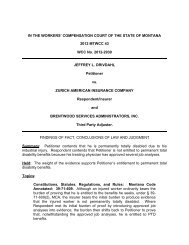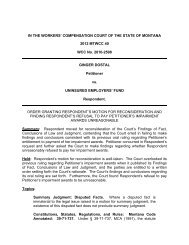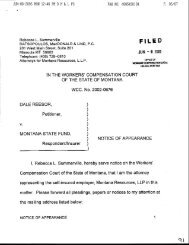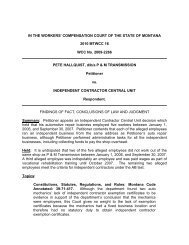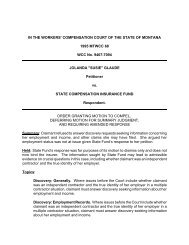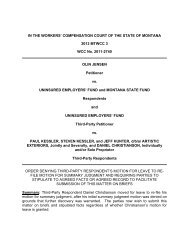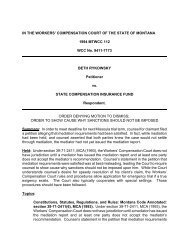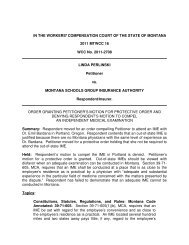Order Resolving Respondent's Motion in Limine and Findings of ...
Order Resolving Respondent's Motion in Limine and Findings of ...
Order Resolving Respondent's Motion in Limine and Findings of ...
Create successful ePaper yourself
Turn your PDF publications into a flip-book with our unique Google optimized e-Paper software.
IN THE WORKERS’ COMPENSATION COURT OF THE STATE OF MONTANA2012 MTWCC 34WCC No. 2011-2751MARLON CLAPHAMPetitionervs.TWIN CITY FIRE INSURANCE COMPANYRespondent/Insurer.ORDER RESOLVING RESPONDENT’S MOTION IN LIMINE ANDFINDINGS OF FACT, CONCLUSIONS OF LAW AND JUDGMENTSummary: Petitioner suffered a work-related back <strong>in</strong>jury <strong>in</strong> 2002. In 2010, he changedjobs. He later filed an occupational disease claim aga<strong>in</strong>st his new employer.Respondent denied Petitioner’s claim on the grounds that his employment did not causehis back condition. Petitioner contends that he developed a compensable occupationaldisease while work<strong>in</strong>g for Respondent’s <strong>in</strong>sured.Held: Petitioner has not proven that he developed an occupational disease whilework<strong>in</strong>g for Respondent’s <strong>in</strong>sured. He is therefore not entitled to the benefits he seeks.Topics:Witnesses: Experts: Disclosure. Where Petitioner disclosed that hisexpert was expected to <strong>of</strong>fer testimony consistent with her previouslydocumented diagnoses, treatment recommendations, <strong>and</strong> causationop<strong>in</strong>ions, the Court granted Respondent’s motion to exclude testimony atthe expert’s second deposition <strong>in</strong> which she op<strong>in</strong>ed for the first time thatPetitioner’s aggravation was permanent <strong>and</strong> not temporary.Discovery: Experts. Where Petitioner disclosed that his expert wasexpected to <strong>of</strong>fer testimony consistent with her previously documenteddiagnoses, treatment recommendations, <strong>and</strong> causation op<strong>in</strong>ions, theCourt granted Respondent’s motion to exclude testimony at the expert’s
second deposition <strong>in</strong> which she op<strong>in</strong>ed for the first time that Petitioner’saggravation was permanent <strong>and</strong> not temporary.Constitutions, Statutes, Regulations, <strong>and</strong> Rules: Montana CodeAnnotated: 39-71-407. Where Petitioner’s treat<strong>in</strong>g physician op<strong>in</strong>ed thathis work was the fourth <strong>in</strong> importance <strong>of</strong> five factors which contributed tohis degenerative disk disease, the Court concluded that Petitioner’s workwas not the “lead<strong>in</strong>g cause” as set forth <strong>in</strong> § 39-71-407(13), MCA.Occupational Disease: Proximate Cause. Where Petitioner’s treat<strong>in</strong>gphysician op<strong>in</strong>ed that his work was the fourth <strong>in</strong> importance <strong>of</strong> five factorswhich contributed to his degenerative disk disease, the Court concludedthat Petitioner’s work was not the “lead<strong>in</strong>g cause” as set forth <strong>in</strong> § 39-71-407(13), MCA.Injury <strong>and</strong> Accident: Aggravation: Temporary Aggravations. WherePetitioner’s treat<strong>in</strong>g physician op<strong>in</strong>ed that his condition was a temporaryaggravation <strong>of</strong> his pre-exist<strong>in</strong>g condition, another medical expert op<strong>in</strong>edthat Petitioner’s job duties did not aggravate his back condition, <strong>and</strong>Petitioner acknowledged that he had never been pa<strong>in</strong> free s<strong>in</strong>ce aprevious <strong>in</strong>dustrial accident <strong>and</strong> that he suffers frequent, temporaryexacerbations <strong>of</strong> his condition with <strong>in</strong>nocuous activity, the Court concludedthat Petitioner’s work activities only caused a temporary aggravation <strong>of</strong> hispre-exist<strong>in</strong>g condition <strong>and</strong> that liability for any medical treatment wouldrest with the <strong>in</strong>surer liable for Petitioner’s previous <strong>in</strong>dustrial <strong>in</strong>jury. 1 The trial <strong>in</strong> this matter occurred on January 10, 2012, at the Workers’Compensation Court <strong>in</strong> Helena, Montana. Petitioner Marlon Clapham was present <strong>and</strong>was represented by David T. Lighthall. Joe C. Maynard represented Respondent Tw<strong>in</strong>City Fire Insurance Company (Tw<strong>in</strong> City). 2 Exhibits: I admitted Exhibits 1 through 25 without objection. 3 Witnesses <strong>and</strong> Depositions: The parties agreed that the depositions <strong>of</strong> Clapham,L<strong>in</strong>da Slavik, Robert V<strong>in</strong>cent, M.D., Richard Hibbs, Cole Johanssen, Gregory D. Hutton,M.D., Elizabeth “Liz” McDonald, RN, CCM, <strong>and</strong> two depositions <strong>of</strong> Valerie Chyle, APRN,FNP, can be considered part <strong>of</strong> the record. 1 Clapham was sworn <strong>and</strong> testified.1 I will consider Chyle’s depositions subject to my rul<strong>in</strong>g on Tw<strong>in</strong> City’s <strong>Motion</strong> <strong>in</strong> Lim<strong>in</strong>e.<strong>Order</strong> <strong>Resolv<strong>in</strong>g</strong> Respondent’s <strong>Motion</strong> <strong>in</strong> Lim<strong>in</strong>e <strong>and</strong>F<strong>in</strong>d<strong>in</strong>gs <strong>of</strong> Fact, Conclusions <strong>of</strong> Law <strong>and</strong> <strong>Order</strong> - 2
4 Issues Presented: The F<strong>in</strong>al Pretrial <strong>Order</strong> sets forth the follow<strong>in</strong>g issues: 2Issue One: Whether Petitioner suffered a compensable occupationaldisease <strong>in</strong> his employment with Crown Parts pursuant to §§ 39-71-407(9)<strong>and</strong> (10), MCA.Issue Two: Whether Respondent complied with the statutoryrequirements <strong>of</strong> § 39-71-608, MCA.Issue Three: If Respondent did not comply with the statutoryrequirements <strong>of</strong> § 39-71-608, MCA, whether its noncompliance constitutesa waiver <strong>of</strong> its defenses <strong>and</strong> acceptance <strong>of</strong> the claim.Issue Four: If Respondent did not comply with the statutory requirements<strong>of</strong> § 39-71-608, MCA, whether a penalty should be assessed on allbenefits payable to Petitioner pursuant to § 39-71-2907, MCA.Issue Five: If Respondent did not comply with the statutory requirements<strong>of</strong> § 39-71-608, MCA, whether Petitioner should be awarded hisreasonable attorney’s fees pursuant to §§ 39-71-611 or -612, MCA.Issue Six: Whether Petitioner suffered a non-work related <strong>in</strong>jury on orabout November 27, 2010, which proximately caused his currentcondition.Issue Seven: Whether the non-work related <strong>in</strong>jury on or aboutNovember 27, 2010, severed liability per § 39-71-407, MCA.Issue Eight: Whether Petitioner’s condition was caused <strong>and</strong>/oraggravated by driv<strong>in</strong>g from Stevensville to Bill<strong>in</strong>gs.RESPONDENT’S MOTION IN LIMINE 5 On December 21, 2011, Tw<strong>in</strong> City filed a motion <strong>in</strong> lim<strong>in</strong>e <strong>and</strong> asked the Court toexclude op<strong>in</strong>ions <strong>of</strong>fered by Valerie Chyle, APRN, FNP, dur<strong>in</strong>g her December 16, 2011,deposition. In particular, Tw<strong>in</strong> City objected to two pieces <strong>of</strong> Chyle’s testimony: herop<strong>in</strong>ion that Clapham was not at maximum medical improvement (MMI) when he felt a“pop” <strong>in</strong> his back while prepar<strong>in</strong>g to shovel snow at home, <strong>and</strong> her op<strong>in</strong>ion that2 F<strong>in</strong>al Pretrial <strong>Order</strong> at 13.<strong>Order</strong> <strong>Resolv<strong>in</strong>g</strong> Respondent’s <strong>Motion</strong> <strong>in</strong> Lim<strong>in</strong>e <strong>and</strong>F<strong>in</strong>d<strong>in</strong>gs <strong>of</strong> Fact, Conclusions <strong>of</strong> Law <strong>and</strong> <strong>Order</strong> - 3
Clapham’s alleged occupational disease is a permanent aggravation <strong>of</strong> an underly<strong>in</strong>gcondition. 3 6 Tw<strong>in</strong> City argues that Chyle’s testimony should be excluded because it isuntimely. Tw<strong>in</strong> City po<strong>in</strong>ts out that at the time <strong>of</strong> the exchange deadl<strong>in</strong>e <strong>in</strong> this case,Clapham had disclosed the follow<strong>in</strong>g regard<strong>in</strong>g Chyle:Valerie Chyle, APRN, is expected to testify concern<strong>in</strong>g her diagnoses <strong>and</strong>treatment <strong>of</strong> Petitioner’s low back condition, <strong>and</strong> the causation op<strong>in</strong>ionsshe <strong>of</strong>fered <strong>in</strong> response [to] a letter form L<strong>in</strong>da Slavik dated December 29,2010, <strong>and</strong> <strong>in</strong> response to a letter from David Lighthall dated March 28,2011. Ms. Chyle is expected to <strong>of</strong>fer testimony consistent with thediagnoses, treatment recommendations, <strong>and</strong> causation op<strong>in</strong>ionsdocumented <strong>in</strong> her treatment notes <strong>and</strong> the above-referenced letters,which are presumed to be <strong>in</strong> Respondent[’]s possession. The grounds forMs. Chyle’s op<strong>in</strong>ions are her treatment <strong>of</strong> Petitioner for his low backcondition, Petitioner’s history <strong>of</strong> how his condition developed, Ms. Chyle’sreview <strong>of</strong> Petitioner’s prior treatment records, <strong>and</strong> her education, tra<strong>in</strong><strong>in</strong>g,<strong>and</strong> expertise as an Advanced Practice Registered Nurse[.] 4 7 Tw<strong>in</strong> City argues that, although Chyle possessed the medical records concern<strong>in</strong>gthe “pop” <strong>in</strong>cident, she never mentioned these records <strong>in</strong> her treatment notes or recordsnor, prior to her December 16, 2011, deposition, did she <strong>of</strong>fer the op<strong>in</strong>ion that Claphamhad not reached MMI prior to the “pop” <strong>in</strong>cident. Tw<strong>in</strong> City further contends that, prior tothis deposition, Chyle repeatedly <strong>and</strong> consistently characterized Clapham’s backcondition as a temporary aggravation <strong>of</strong> a chronic pre-exist<strong>in</strong>g condition, <strong>and</strong> thatClapham failed to disclose that Chyle had changed her op<strong>in</strong>ion prior to this deposition.Tw<strong>in</strong> City therefore asks the Court to exclude Chyle’s December 16, 2011, depositiontestimony on these two items. Tw<strong>in</strong> City alleges that permitt<strong>in</strong>g Clapham to <strong>of</strong>fer twonew expert op<strong>in</strong>ions long past the exchange deadl<strong>in</strong>e would be highly prejudicial asTw<strong>in</strong> City was deprived <strong>of</strong> the opportunity to “explore the topic” or obta<strong>in</strong> rebuttalop<strong>in</strong>ions. 5 8 Clapham objects to Tw<strong>in</strong> City’s motions. He argues that Chyle’s testimony isrelevant <strong>and</strong> admissible, that Chyle was timely disclosed as an expert witness, <strong>and</strong> thatthe subject matter <strong>of</strong> her potential testimony at trial was likewise disclosed <strong>in</strong> a timely3 <strong>Motion</strong> <strong>in</strong> Lim<strong>in</strong>e, Docket Item No. 51.4 Ex. 2 at 3 to <strong>Motion</strong> <strong>in</strong> Lim<strong>in</strong>e.5 <strong>Motion</strong> <strong>in</strong> Lim<strong>in</strong>e at 2-3.<strong>Order</strong> <strong>Resolv<strong>in</strong>g</strong> Respondent’s <strong>Motion</strong> <strong>in</strong> Lim<strong>in</strong>e <strong>and</strong>F<strong>in</strong>d<strong>in</strong>gs <strong>of</strong> Fact, Conclusions <strong>of</strong> Law <strong>and</strong> <strong>Order</strong> - 4
manner. 6 Tw<strong>in</strong> City does not dispute that Chyle’s testimony is relevant, or that she wastimely disclosed as an expert witness. The only issue is whether the subject matter <strong>of</strong>Chyle’s potential testimony was timely disclosed; therefore, I address only that portion<strong>of</strong> Clapham’s brief. 9 Argu<strong>in</strong>g that Chyle’s op<strong>in</strong>ion testimony should not be excluded, Clapham reliesupon Uffalussy v. St. Patrick Hospital <strong>and</strong> Health Sciences Center 7 <strong>and</strong> Ostermiller v.Alvord. 8 In Uffalussy, the <strong>in</strong>surer objected to a doctor provid<strong>in</strong>g any op<strong>in</strong>ion outside thescope <strong>of</strong> his treatment notes. Uffalussy’s expert witness disclosure regard<strong>in</strong>g the doctorstated, <strong>in</strong> pert<strong>in</strong>ent part:We would expect the medical care providers <strong>and</strong> evaluators totestify based upon their personal observations as well as the cumulativemedical records. We would expect them to testify consistent with theirmedical records <strong>and</strong> reports . . . . 9I characterized Uffalussy’s disclosure as “broad” <strong>and</strong> noted that if the <strong>in</strong>surer hadobjected to the adequacy <strong>of</strong> the disclosure <strong>in</strong> accordance with the Schedul<strong>in</strong>g <strong>Order</strong>, Imay well have found the objection well-taken. However, from the record it appearedthat the <strong>in</strong>surer had never followed the procedure for object<strong>in</strong>g to an allegedly<strong>in</strong>adequate disclosure, <strong>and</strong> I found that the op<strong>in</strong>ions <strong>of</strong>fered by the expert witness at trialfell with<strong>in</strong> the broad parameters set forth <strong>in</strong> Uffalussy’s disclosure. 10 10 In Ostermiller, the Montana Supreme Court rejected the appellant’s argumentthat the testimony <strong>of</strong> his treat<strong>in</strong>g physician, called to testify by the respondent, shouldhave been excluded on the grounds that the respondent failed to list the treat<strong>in</strong>gphysician <strong>in</strong> its response to the appellant’s <strong>in</strong>terrogatory regard<strong>in</strong>g the names <strong>of</strong> expertwitnesses to be called at trial. The court noted that the respondent had identified thedoctor as a witness <strong>in</strong> another <strong>in</strong>terrogatory, <strong>and</strong> further stated:Dr. Black was listed by the defendant as a witness <strong>in</strong> the pretrial orderdated February 20, 1985. Further, Dr. Black was deposed by both partiesprior to trial. Dr. Black was a treat<strong>in</strong>g physician for the pla<strong>in</strong>tiff <strong>and</strong> <strong>in</strong> noway could be classed as a surprise witness. Pla<strong>in</strong>tiff has not contended6 Petitioner’s Brief <strong>in</strong> Response to Respondent’s <strong>Motion</strong> <strong>in</strong> Lim<strong>in</strong>e (Response to <strong>Motion</strong> <strong>in</strong> Lim<strong>in</strong>e), DocketItem No. 55.7 Uffalussy, 2007 MTWCC 45.8 Ostermiller, 222 Mont. 208, 720 P.2d 1198 (1986).9 Uffalussy, 65.10 Uffalussy, 66.<strong>Order</strong> <strong>Resolv<strong>in</strong>g</strong> Respondent’s <strong>Motion</strong> <strong>in</strong> Lim<strong>in</strong>e <strong>and</strong>F<strong>in</strong>d<strong>in</strong>gs <strong>of</strong> Fact, Conclusions <strong>of</strong> Law <strong>and</strong> <strong>Order</strong> - 5
that he was surprised <strong>in</strong> any respect by the testimony <strong>of</strong> Dr. Black. Hehas only argued that defendant failed to list Dr. Black as an expertwitness. We f<strong>in</strong>d that such an argument is hyper-technical <strong>in</strong> view <strong>of</strong> the<strong>in</strong>formation furnished to the pla<strong>in</strong>tiff. We conclude that the admission <strong>of</strong>Dr. Black’s testimony was proper. 11 11 In his response brief, Clapham acknowledges that Chyle previouslycharacterized the aggravation <strong>of</strong> his pre-exist<strong>in</strong>g low-back condition as temporary onmultiple occasions, <strong>in</strong>clud<strong>in</strong>g dur<strong>in</strong>g a previous deposition <strong>in</strong> this case. 12 There is noquestion that Chyle’s later testimony that Clapham suffered a permanent aggravation isat odds with Clapham’s disclosure, which stated <strong>in</strong> part, “Ms. Chyle is expected to <strong>of</strong>fertestimony consistent with the diagnoses, treatment recommendations, <strong>and</strong> causationop<strong>in</strong>ions documented . . . .” 13 The cases Clapham cites are readily dist<strong>in</strong>guishable fromthe present case. Unlike the situation <strong>in</strong> Uffalussy, <strong>in</strong> which the disclosure was vague,Chyle repeatedly op<strong>in</strong>ed that the aggravation <strong>of</strong> Clapham’s pre-exist<strong>in</strong>g back conditionwas temporary. There is noth<strong>in</strong>g “hyper-technical” about Tw<strong>in</strong> City’s objection to Chyle<strong>of</strong>fer<strong>in</strong>g testimony which was anyth<strong>in</strong>g but “consistent with the . . . causation op<strong>in</strong>ionsdocumented.” 12 Tw<strong>in</strong> City’s motion is granted. Chyle’s testimony at her December 16, 2011,deposition <strong>in</strong> which she op<strong>in</strong>ed that Clapham’s alleged occupational disease is apermanent aggravation <strong>of</strong> an underly<strong>in</strong>g condition, is excluded. As for Chyle’s op<strong>in</strong>ionregard<strong>in</strong>g Clapham’s MMI status at the time he felt a “pop” <strong>in</strong> his back, as set forthbelow, I have not reached Issues Six <strong>and</strong> Seven. Therefore, Chyle’s op<strong>in</strong>ion regard<strong>in</strong>gClapham’s MMI status at that time is irrelevant.FINDINGS OF FACT 13 Clapham testified at trial. I did not f<strong>in</strong>d Clapham’s testimony wholly credible.However, for purpose <strong>of</strong> these f<strong>in</strong>d<strong>in</strong>gs I have taken Clapham’s testimony as true. Theoutcome <strong>of</strong> the case does not h<strong>in</strong>ge on Clapham’s credibility but rather on the medicalevidence presented. 14 Clapham is a general mach<strong>in</strong>ist. 14 In March 1992, he began work<strong>in</strong>g for SmurfitStone Conta<strong>in</strong>er Corp. (Smurfit Stone) <strong>in</strong> Missoula. 15 He averaged 50 to 60 hours <strong>of</strong>11 Ostermiller, 222 Mont. at 212, 720 P.2d at 1201.12 Response to <strong>Motion</strong> <strong>in</strong> Lim<strong>in</strong>e at 2-3.13 See 6, above. (Emphasis added.)14 Trial Test.<strong>Order</strong> <strong>Resolv<strong>in</strong>g</strong> Respondent’s <strong>Motion</strong> <strong>in</strong> Lim<strong>in</strong>e <strong>and</strong>F<strong>in</strong>d<strong>in</strong>gs <strong>of</strong> Fact, Conclusions <strong>of</strong> Law <strong>and</strong> <strong>Order</strong> - 6
work per week. Clapham testified that he regularly lifted 10 to 15 pounds, <strong>and</strong> rarelylifted more than 20 to 25 pounds because he used a crane to move heavier pieces. 16 15 Clapham testified that he first aggravated his back on October 15, 2002. He<strong>in</strong>itially treated with Georgia Milan, M.D., <strong>and</strong> he also sought chiropractic treatment. Hedid not miss any work from the <strong>in</strong>jury. 17 16 On May 19, 2003, Clapham underwent a lumbar MRI which revealed mild tomoderate degenerative changes from L3 through S1 with a slight narrow<strong>in</strong>g <strong>of</strong> the canalat L3-4, disk desiccation <strong>and</strong> diffuse bulg<strong>in</strong>g <strong>of</strong> the disk annulus without focal protrusionat L4-5, <strong>and</strong> disk desiccation <strong>and</strong> diffuse bulg<strong>in</strong>g <strong>of</strong> the disk annulus at L5-S1 with morefocal central disk protrusion extend<strong>in</strong>g to the ventral surface <strong>of</strong> the thecal sac. 18 17 On June 3, 2003, Clapham signed a First Report <strong>of</strong> Injury (FROI), claim<strong>in</strong>g thaton October 15, 2002, he stra<strong>in</strong>ed his lower back while lift<strong>in</strong>g a lathe bed <strong>in</strong>to position. 19 18 On August 18, 2003, Chriss A. Mack, M.D., op<strong>in</strong>ed that Clapham was at MMI foracute my<strong>of</strong>ascial pa<strong>in</strong> syndrome. Dr. Mack op<strong>in</strong>ed that Clapham’s symptoms werecaused by one <strong>of</strong> two bulg<strong>in</strong>g disks <strong>and</strong> he assigned Clapham a 7% whole personimpairment rat<strong>in</strong>g. 20 Clapham testified that he cont<strong>in</strong>ued to have periodic flare ups <strong>of</strong> hisback condition after Dr. Mack placed him at MMI. 21 19 On August 23, 2004, John C. Schumpert, M.D., MPH, issued an <strong>in</strong>dependentmedical exam<strong>in</strong>ation (IME) report regard<strong>in</strong>g Clapham’s condition <strong>and</strong> whetherClapham’s ongo<strong>in</strong>g chiropractic care should be considered “ma<strong>in</strong>tenance or curative <strong>in</strong>nature.” Dr. Schumpert op<strong>in</strong>ed that chiropractic care would be palliative <strong>in</strong> nature <strong>and</strong>that it was helpful <strong>in</strong> ma<strong>in</strong>ta<strong>in</strong><strong>in</strong>g Clapham’s level <strong>of</strong> function<strong>in</strong>g. Dr. Schumpert furtherop<strong>in</strong>ed that Clapham was at MMI <strong>and</strong> he did not believe more aggressive treatment waswarranted. 2215 Trial Test.16 Trial Test.17 Trial Test.18 Ex. 1 at 135.19 Ex. 1 at 152.20 Ex. 1 at 130.21 Clapham Dep. 53:13-15.22 Ex. 1 at 115-120.<strong>Order</strong> <strong>Resolv<strong>in</strong>g</strong> Respondent’s <strong>Motion</strong> <strong>in</strong> Lim<strong>in</strong>e <strong>and</strong>F<strong>in</strong>d<strong>in</strong>gs <strong>of</strong> Fact, Conclusions <strong>of</strong> Law <strong>and</strong> <strong>Order</strong> - 7
20 Clapham testified that <strong>in</strong> March 2005, he began to experience numbness <strong>in</strong> hislegs. He reduced his recreational activities because he did not want to furtheraggravate his condition. Clapham testified that he did not miss any work from October2002 through March 2005, but he worked through significant pa<strong>in</strong> <strong>and</strong> flare ups. 23 21 Clapham testified that <strong>in</strong> March 2006, he exacerbated his back condition whenhe attempted to build a fire while recreat<strong>in</strong>g on his snowmobile. After that <strong>in</strong>cident, hemissed a few days <strong>of</strong> work <strong>and</strong> reduced his recreational activities. 24 22 On March 14, 2006, Clapham underwent a repeat lumbar MRI. The f<strong>in</strong>d<strong>in</strong>gs<strong>in</strong>dicated that Clapham had a small hemangioma with<strong>in</strong> the L3 vertebral body with milddegenerative disk disease at L4 <strong>and</strong> L5-S1, a mild central disk protrusion withassociated posterior annular tear at L4-5, a mild central disk protrusion at L5-S1 mildlycontact<strong>in</strong>g the descend<strong>in</strong>g right S1 nerve root without significant sp<strong>in</strong>al canal stenosis,<strong>and</strong> mild relative canal stenosis at L3-4. 25 23 On May 15, 2006, Dana Headapohl, M.D., MPH, conducted an IME.Dr. Headapohl diagnosed Clapham with mechanical low-back pa<strong>in</strong> with <strong>in</strong>termittent rightleg parethesias <strong>and</strong> mild degenerative disk disease at L4-5 <strong>and</strong> L5-S1 with a posteriorannular tear at L4-5 <strong>and</strong> relative sp<strong>in</strong>al canal stenosis <strong>and</strong> mild bilateral recess stenosis.Dr. Headapohl op<strong>in</strong>ed that the 2002 <strong>in</strong>dustrial <strong>in</strong>jury was the major contribut<strong>in</strong>g causefor Clapham’s ongo<strong>in</strong>g need for medical treatment, not<strong>in</strong>g that Clapham was found atMMI <strong>in</strong> 2004 “with ongo<strong>in</strong>g symptoms, lumbar radiculopathy, <strong>and</strong> need for ongo<strong>in</strong>gma<strong>in</strong>tenance therapy.” Dr. Headapohl op<strong>in</strong>ed that Clapham had returned to pre<strong>in</strong>jurybasel<strong>in</strong>e from his March 2006 exacerbation. 26 24 On November 27, 2007, Dr. Milan treated Clapham for an acute exacerbation <strong>of</strong>his low-back pa<strong>in</strong>, not<strong>in</strong>g that Clapham had an acute onset <strong>of</strong> pa<strong>in</strong> while pull<strong>in</strong>g a cart.Dr. Milan prescribed a pa<strong>in</strong> reliever <strong>and</strong> aggressive physical therapy. 27 On April 21,2008, Dr. Milan op<strong>in</strong>ed that Clapham had returned to his pre-exacerbation basel<strong>in</strong>e <strong>and</strong>that any back problems he was now experienc<strong>in</strong>g related to his 2002 <strong>in</strong>dustrial <strong>in</strong>jury. 2823 Trial Test.24 Trial Test.25 Ex. 1 at 133-34.26 Ex. 1 at 63-77.27 Ex. 1 at 138.28 Ex. 1 at 137.<strong>Order</strong> <strong>Resolv<strong>in</strong>g</strong> Respondent’s <strong>Motion</strong> <strong>in</strong> Lim<strong>in</strong>e <strong>and</strong>F<strong>in</strong>d<strong>in</strong>gs <strong>of</strong> Fact, Conclusions <strong>of</strong> Law <strong>and</strong> <strong>Order</strong> - 8
25 Clapham testified that after Smurfit Stone ceased pay<strong>in</strong>g for his chiropractictreatment under his 2002 claim, he sought chiropractic care under his health <strong>in</strong>surance.Clapham testified that he typically went several times each month, but decreased hisvisits when he participated <strong>in</strong> physical therapy. 29 Clapham testified that if he did not getphysical therapy or chiropractic care on a regular basis, his back condition deteriorated<strong>and</strong> he experienced <strong>in</strong>creased stiffness <strong>and</strong> pa<strong>in</strong>. 30 26 In January 2010, Clapham was laid <strong>of</strong>f from his job at Smurfit Stone. 31 OnJuly 19, 2010, Clapham began work<strong>in</strong>g for Crown Parts. 32 Clapham testified that heceased the chiropractic treatment <strong>and</strong> physical therapy prior to beg<strong>in</strong>n<strong>in</strong>g work at CrownParts because he felt like he had reached a ma<strong>in</strong>ta<strong>in</strong>able level <strong>of</strong> comfort. However,although Clapham alleged that he chose to stop treatment because he did not believehe needed it, he admitted that he stopped receiv<strong>in</strong>g treatment when his workers’compensation <strong>in</strong>surer stopped pay<strong>in</strong>g for it, <strong>and</strong> that the <strong>in</strong>ability to afford treatmentlimited his mobility <strong>and</strong> <strong>in</strong>creased his back pa<strong>in</strong>. Clapham further acknowledged that attimes, his back pa<strong>in</strong> flared up while he was receiv<strong>in</strong>g chiropractic treatment <strong>and</strong> physicaltherapy. Clapham admitted that he occasionally took vacation time <strong>of</strong>f work because <strong>of</strong>sudden flare ups <strong>of</strong> his back condition, <strong>and</strong> that he experienced acute pa<strong>in</strong> shoot<strong>in</strong>gdown <strong>in</strong>to his legs before he began work<strong>in</strong>g at Crown Parts. 33 27 Clapham testified that he has never had a pa<strong>in</strong>-free day s<strong>in</strong>ce his 2002 <strong>in</strong>dustrial<strong>in</strong>jury. Clapham testified that his average pa<strong>in</strong> level at Smurfit Stone was between athree out <strong>of</strong> ten <strong>and</strong> a five out <strong>of</strong> ten, but by 2005, his basel<strong>in</strong>e pa<strong>in</strong> was about a five out<strong>of</strong> ten <strong>and</strong> it would <strong>in</strong>crease to eight or n<strong>in</strong>e. Clapham testified that when he wasunemployed before go<strong>in</strong>g to work for Crown Parts, his pa<strong>in</strong> was approximately a threeout <strong>of</strong> ten <strong>and</strong> he found that he could ignore the pa<strong>in</strong> unless he twisted the wrong way. 34 28 When Clapham worked for Crown Parts, he commuted to Bill<strong>in</strong>gs from his home<strong>in</strong> Stevensville. Once he began work<strong>in</strong>g the night shift, he either drove to Bill<strong>in</strong>gs onSunday night or Monday morn<strong>in</strong>g, <strong>and</strong> his shift started at 2:00 p.m. on Monday. He29 Clapham Dep. 56:23 – 57:10.30 Clapham Dep. 59:24 – 60:10.31 Trial Test.32 Trial Test.33 Trial Test.34 Trial Test.<strong>Order</strong> <strong>Resolv<strong>in</strong>g</strong> Respondent’s <strong>Motion</strong> <strong>in</strong> Lim<strong>in</strong>e <strong>and</strong>F<strong>in</strong>d<strong>in</strong>gs <strong>of</strong> Fact, Conclusions <strong>of</strong> Law <strong>and</strong> <strong>Order</strong> - 9
worked four 12-hour shifts <strong>and</strong> then spent the night <strong>in</strong> an apartment <strong>in</strong> Bill<strong>in</strong>gs. Hedrove home to Stevensville each Friday morn<strong>in</strong>g <strong>and</strong> spent the weekend with his wife. 35 29 Clapham testified that his job duties at Crown Parts required him to be <strong>in</strong> front <strong>of</strong>his lathe for his entire shift except for breaks. On some days, Clapham only sat downon his 20-m<strong>in</strong>ute d<strong>in</strong>ner break. Occasionally, a mach<strong>in</strong><strong>in</strong>g job allowed him to sit or leanfor periods <strong>of</strong> time. Clapham testified that constant st<strong>and</strong><strong>in</strong>g aggravated his back pa<strong>in</strong>. 36 30 Clapham testified that from July 19, 2010, <strong>in</strong>to September 2010, he believed hisback was do<strong>in</strong>g well. He did not notice an <strong>in</strong>crease <strong>in</strong> back pa<strong>in</strong> when he drove toBill<strong>in</strong>gs at the start <strong>of</strong> each work week. He also did not notice an <strong>in</strong>crease <strong>in</strong> back pa<strong>in</strong>when he drove back to Stevensville at the end <strong>of</strong> the week. Clapham testified that healways stopped frequently to walk around while driv<strong>in</strong>g long distances. 37 31 Clapham testified that by the third week <strong>of</strong> October, he felt stiffer <strong>and</strong> <strong>in</strong>creasedhis dosages <strong>of</strong> muscle relaxant <strong>and</strong> over-the-counter pa<strong>in</strong> reliever. Clapham testifiedthat he cont<strong>in</strong>ued to manage the drive to Bill<strong>in</strong>gs <strong>and</strong> back without any significant<strong>in</strong>crease <strong>in</strong> stiffness or pa<strong>in</strong>. His back felt normal dur<strong>in</strong>g his weekends <strong>of</strong>f. Claphamtestified, however, that he was never pa<strong>in</strong> free <strong>and</strong> that he had never been pa<strong>in</strong> frees<strong>in</strong>ce his October 2002 <strong>in</strong>dustrial <strong>in</strong>jury. 38 32 In early November 2010, Clapham noticed <strong>in</strong>creas<strong>in</strong>g stiffness <strong>and</strong> a decrease <strong>in</strong>his range <strong>of</strong> motion. Clapham testified that at that time, he typically felt well on Monday<strong>and</strong> Tuesday, but by Wednesday he would <strong>in</strong>crease his medications. The <strong>in</strong>tensity <strong>of</strong>his pa<strong>in</strong> <strong>and</strong> stiffness <strong>in</strong>creased by Thursday afternoon. 39 33 Clapham testified that dur<strong>in</strong>g the week <strong>of</strong> Thanksgiv<strong>in</strong>g <strong>in</strong> November 2010, hedrove to Bill<strong>in</strong>gs on Monday morn<strong>in</strong>g <strong>and</strong> completed his first shift without <strong>in</strong>cident. OnTuesday, Clapham felt very stiff <strong>and</strong> his pa<strong>in</strong> levels were <strong>in</strong>creas<strong>in</strong>g prior to the start <strong>of</strong>his shift. Afterward, he had difficulty gett<strong>in</strong>g out <strong>of</strong> his car at his Bill<strong>in</strong>gs apartment. OnWednesday, Clapham experienced <strong>in</strong>creased pa<strong>in</strong> <strong>and</strong> stiffness prior to his lunch break<strong>and</strong> he took more than his usual dosage <strong>of</strong> medication. After his lunch break, Clapham35 Trial Test.36 Trial Test.37 Trial Test.38 Trial Test.39 Trial Test.<strong>Order</strong> <strong>Resolv<strong>in</strong>g</strong> Respondent’s <strong>Motion</strong> <strong>in</strong> Lim<strong>in</strong>e <strong>and</strong>F<strong>in</strong>d<strong>in</strong>gs <strong>of</strong> Fact, Conclusions <strong>of</strong> Law <strong>and</strong> <strong>Order</strong> - 10
had difficulty st<strong>and</strong><strong>in</strong>g up. Clapham returned to his lathe <strong>and</strong> f<strong>in</strong>ished the piece he hadbeen work<strong>in</strong>g on. 40 34 After Clapham’s shift ended, he sat <strong>in</strong> his car for a few m<strong>in</strong>utes before driv<strong>in</strong>gaway. When he arrived at his Bill<strong>in</strong>gs apartment, he had to use his h<strong>and</strong>s to lift his legsout <strong>of</strong> the vehicle. He fell when he attempted to st<strong>and</strong> up. Clapham testified that hecrawled <strong>in</strong>to his apartment <strong>and</strong> went straight to bed. He awoke on Thanksgiv<strong>in</strong>gmorn<strong>in</strong>g <strong>and</strong> decided to drive home as soon as possible because he believed he wasgo<strong>in</strong>g to cont<strong>in</strong>ue to stiffen. 41 35 Clapham testified that he had a “miserable” drive from Bill<strong>in</strong>gs to Stevensville.He stopped frequently <strong>and</strong> attempted to walk around. On many <strong>of</strong> his stops, he simplygot out <strong>of</strong> the car <strong>and</strong> stood hold<strong>in</strong>g on to the vehicle. By the time Clapham reachedhome, he was experienc<strong>in</strong>g pa<strong>in</strong> more severe than he had ever felt previously.Clapham took a hot shower, ate d<strong>in</strong>ner, <strong>and</strong> went to bed. 42 36 The follow<strong>in</strong>g morn<strong>in</strong>g, Clapham was still <strong>in</strong> a great deal <strong>of</strong> pa<strong>in</strong>. He spent theday on the couch. If he bent over, he had muscle spasms when he tried to straightenup. 43 37 Clapham testified that from November 25, 2010, through November 27, 2010, hespent his time rest<strong>in</strong>g on the couch or <strong>in</strong> bed <strong>and</strong> was not do<strong>in</strong>g any bend<strong>in</strong>g ortwist<strong>in</strong>g. 44 On the morn<strong>in</strong>g <strong>of</strong> November 27, 2010, he decided to use his hot tub. Hewas retriev<strong>in</strong>g a broom to brush snow <strong>of</strong>f the walkway lead<strong>in</strong>g to the hot tub when hehad a severe muscle spasm. His wife helped him onto the couch <strong>and</strong> he spent the rest<strong>of</strong> the day there. Clapham testified that he never actually swept any snow with thebroom. 45 38 On Sunday, November 28, 2010, Clapham went to the emergency room at hiswife’s <strong>in</strong>sistence because he was unable to get out <strong>of</strong> bed without assistance thatmorn<strong>in</strong>g. 4640 Trial Test.41 Trial Test.42 Trial Test.43 Trial Test.44 Trial Test.45 Trial Test.46 Trial Test.<strong>Order</strong> <strong>Resolv<strong>in</strong>g</strong> Respondent’s <strong>Motion</strong> <strong>in</strong> Lim<strong>in</strong>e <strong>and</strong>F<strong>in</strong>d<strong>in</strong>gs <strong>of</strong> Fact, Conclusions <strong>of</strong> Law <strong>and</strong> <strong>Order</strong> - 11
39 Clapham testified that the prescribed medication relieved his symptoms. Thenext day, he saw Gregory D. Hutton, M.D., because he wanted a work release.Clapham testified that he told Dr. Hutton about hav<strong>in</strong>g a spasm the day before while<strong>in</strong>tend<strong>in</strong>g to shovel snow so that he could use his hot tub. Clapham testified that he didnot tell Dr. Hutton that he had a snap or a pop <strong>in</strong> his back <strong>and</strong> that he does not recallhear<strong>in</strong>g a pop <strong>in</strong> his back. 47 40 Dr. Hutton is a physician certified by the American Board <strong>of</strong> Family Practice. 48Dr. Hutton saw Clapham on one occasion: November 29, 2010. 49 Dr. Hutton noted thatClapham had <strong>in</strong>termittent flare ups <strong>of</strong> low-back pa<strong>in</strong> s<strong>in</strong>ce his 2002 <strong>in</strong>dustrial <strong>in</strong>jury. Henoted that Clapham felt a “pop” or “snap” <strong>in</strong> his back when he was walk<strong>in</strong>g outdoorswhile plann<strong>in</strong>g to shovel snow. Dr. Hutton diagnosed Clapham with an acuteexacerbation <strong>of</strong> chronic lower back pa<strong>in</strong> <strong>and</strong> took him <strong>of</strong>f work for two weeks. 50 41 On November 29, 2010, Clapham signed a FROI claim<strong>in</strong>g, “Work activities haveaggravated back <strong>and</strong> caused <strong>in</strong>creas<strong>in</strong>g back pa<strong>in</strong> over last couple <strong>of</strong> months.” 51Clapham has not returned to work s<strong>in</strong>ce November 2010. 52 42 Valerie Chyle, APRN, FNP, 53 is board-certified as a family nurse practitioner. 54Her practice specialty is the rehabilitation <strong>and</strong> pa<strong>in</strong> management <strong>of</strong> <strong>in</strong>jured workers. 55On December 15, 2010, Chyle saw Clapham for an <strong>in</strong>itial evaluation. Clapham wasreferred by the nurse consultant with the Carey Law Firm for evaluation <strong>and</strong> possibleassumption <strong>of</strong> care. Chyle reported that although Clapham had suffered an <strong>in</strong>dustrial<strong>in</strong>jury to his low back <strong>in</strong> October 2002, he had been do<strong>in</strong>g fairly well until he began hisjob at Crown Parts <strong>in</strong> July 2010. Chyle reported that Clapham experienced worsen<strong>in</strong>gpa<strong>in</strong> with numbness <strong>and</strong> t<strong>in</strong>gl<strong>in</strong>g <strong>in</strong>to his right leg <strong>and</strong> foot. Chyle performed a physicalexam<strong>in</strong>ation <strong>of</strong> Clapham <strong>and</strong> her impression was <strong>of</strong> chronic low-back pa<strong>in</strong> with right L5-S1 radiculopathy with recent aggravation at work <strong>and</strong> multilevel lumbar degenerative47 Trial Test.48 Hutton Dep. 6:7-9.49 Hutton Dep. 7:23 – 8:2.50 Ex. 16 at 1.51 Ex. 1 at 156.52 Trial Test.53 Some <strong>of</strong> the trial exhibits bear Chyle’s former name, “Valerie Benzschawel.” For the sake <strong>of</strong> clarity, she isreferred to Chyle throughout the F<strong>in</strong>d<strong>in</strong>gs <strong>of</strong> Fact, Conclusions <strong>of</strong> Law <strong>and</strong> Judgment.54 Chyle (8/18/11) Dep. 9:20-25.55 Chyle (8/18/11) Dep. 9:3-6.<strong>Order</strong> <strong>Resolv<strong>in</strong>g</strong> Respondent’s <strong>Motion</strong> <strong>in</strong> Lim<strong>in</strong>e <strong>and</strong>F<strong>in</strong>d<strong>in</strong>gs <strong>of</strong> Fact, Conclusions <strong>of</strong> Law <strong>and</strong> <strong>Order</strong> - 12
disk disease. Chyle recommended a repeat lumbar MRI, prescription medication, <strong>and</strong>physical therapy. 56 43 On January 4, 2011, Chyle responded to questions posed by L<strong>in</strong>da Slavik, the<strong>in</strong>itial claims adjuster for Specialty Risk Services on Clapham’s Crown Parts claim.Chyle op<strong>in</strong>ed that Clapham’s back pa<strong>in</strong> was a temporary aggravation <strong>of</strong> his 2002<strong>in</strong>dustrial <strong>in</strong>jury. 57 After receiv<strong>in</strong>g Chyle’s op<strong>in</strong>ion letter, Slavik chose to pursue an IMEbefore mak<strong>in</strong>g a liability determ<strong>in</strong>ation. 58 Slavik testified that she considered Clapham’scase to be complex due to his previous <strong>in</strong>dustrial <strong>in</strong>jury <strong>and</strong> she believed it was prudentto seek the op<strong>in</strong>ion <strong>of</strong> a specialist or physician to determ<strong>in</strong>e causation. 59 44 On January 17, 2011, Clapham underwent a repeat lumbar MRI. The reportcompares this MRI to the 2006 films <strong>and</strong> notes f<strong>in</strong>d<strong>in</strong>gs at T11-12 through L5-S1,<strong>in</strong>clud<strong>in</strong>g disk bulg<strong>in</strong>g with imp<strong>in</strong>gement on the central sp<strong>in</strong>al canal at L1-2 <strong>and</strong> L2-3;disk bulg<strong>in</strong>g with imp<strong>in</strong>gement <strong>and</strong> significant stenosis <strong>and</strong> moderate biforam<strong>in</strong>alstenosis with disk bulg<strong>in</strong>g abutt<strong>in</strong>g the exit<strong>in</strong>g nerve roots bilaterally at L3-4; a diskprotrusion <strong>and</strong> significant stenosis at L4-5, with a mild <strong>in</strong>crease <strong>in</strong> disk protrusion s<strong>in</strong>cethe 2006 MRI; <strong>and</strong> a disk protrusion with significant stenosis at L5-S1, with a milddecrease <strong>in</strong> the disk protrusion s<strong>in</strong>ce the 2006 MRI. 60 45 Robert J. V<strong>in</strong>cent, M.D., is board-certified <strong>in</strong> <strong>in</strong>ternal medic<strong>in</strong>e <strong>and</strong> <strong>in</strong> preventivemedic<strong>in</strong>e with a subspecialty <strong>in</strong> occupational medic<strong>in</strong>e. 61 Currently, Dr. V<strong>in</strong>cent does nottreat patients, but conf<strong>in</strong>es his practice to IMEs. 62 Dr. V<strong>in</strong>cent conducted an IME <strong>of</strong>Clapham on February 8, 2011. 63 In his subsequent report, Dr. V<strong>in</strong>cent noted thatClapham performed his job at Crown Parts without significant difficulties, although hesuffered from chronic low-back pa<strong>in</strong>. Dr. V<strong>in</strong>cent noted that Clapham reported agradual worsen<strong>in</strong>g <strong>of</strong> back pa<strong>in</strong> dur<strong>in</strong>g his employment at Crown Parts. Dr. V<strong>in</strong>centfurther noted that Clapham op<strong>in</strong>ed that his commute was the primary aggravator <strong>of</strong> hisback pa<strong>in</strong>. After a physical exam<strong>in</strong>ation, Dr. V<strong>in</strong>cent op<strong>in</strong>ed that Clapham had anexacerbation <strong>of</strong> chronic low-back pa<strong>in</strong> secondary to long-distance driv<strong>in</strong>g, multileveldegenerative disk disease which pre-existed November 2010, right extremity pa<strong>in</strong> <strong>and</strong>56 Ex. 1 at 164-69.57 Ex. 1 at 176-77.58 Slavik Dep. 41:20 – 42:4.59 Slavik Dep. 42:11-12, 43:2-17, 44:8-11.60 Ex. 1 at 183-84.61 V<strong>in</strong>cent Dep. 9:4-9.62 V<strong>in</strong>cent Dep. 12:9-20.63 V<strong>in</strong>cent Dep. 13:20 – 14:1.<strong>Order</strong> <strong>Resolv<strong>in</strong>g</strong> Respondent’s <strong>Motion</strong> <strong>in</strong> Lim<strong>in</strong>e <strong>and</strong>F<strong>in</strong>d<strong>in</strong>gs <strong>of</strong> Fact, Conclusions <strong>of</strong> Law <strong>and</strong> <strong>Order</strong> - 13
t<strong>in</strong>gl<strong>in</strong>g primarily <strong>in</strong> the S1 distribution, <strong>and</strong> probable depression. Dr. V<strong>in</strong>cent op<strong>in</strong>edthat “noth<strong>in</strong>g” <strong>in</strong> Clapham’s job history or work duties suggested that his job aggravatedhis back condition. Dr. V<strong>in</strong>cent further op<strong>in</strong>ed that Clapham’s work at Crown Parts wasnot the major contribut<strong>in</strong>g cause <strong>of</strong> his back pa<strong>in</strong>, but rather his pa<strong>in</strong> was caused by acomb<strong>in</strong>ation <strong>of</strong> the natural progression <strong>of</strong> his underly<strong>in</strong>g degenerative disk disease <strong>and</strong>his commute. Dr. V<strong>in</strong>cent further op<strong>in</strong>ed that Clapham did not susta<strong>in</strong> an aggravation <strong>of</strong>his 2002 <strong>in</strong>dustrial <strong>in</strong>jury <strong>and</strong> that he rema<strong>in</strong>ed at MMI. 64 46 Dr. V<strong>in</strong>cent testified that he found objective medical f<strong>in</strong>d<strong>in</strong>gs <strong>of</strong> multileveldegenerative disk disease, chronic low-back pa<strong>in</strong>, <strong>and</strong> radicular f<strong>in</strong>d<strong>in</strong>gs <strong>in</strong> the lowerextremity consistent with x-ray f<strong>in</strong>d<strong>in</strong>gs. 65 Dr. V<strong>in</strong>cent testified that he reviewedClapham’s most recent MRI, compared his f<strong>in</strong>d<strong>in</strong>gs to the reports from the previousMRIs, <strong>and</strong> concluded that there were some changes consistent with a naturalprogression <strong>of</strong> degenerative changes. 66 Dr. V<strong>in</strong>cent testified:And Mr. Clapham told me – I asked him several times, to get it straight,what at his work was caus<strong>in</strong>g his back to be worse, <strong>and</strong> he repeatedly toldme that he didn’t th<strong>in</strong>k it was anyth<strong>in</strong>g different about Crown Parts thanthe work he had done at Stone <strong>and</strong> that he could get through that with hismedication <strong>and</strong> his regimen <strong>of</strong> treatment.What he told me was that his driv<strong>in</strong>g the six <strong>and</strong> a half hoursbetween Bill<strong>in</strong>gs <strong>and</strong> Missoula was, <strong>in</strong> his op<strong>in</strong>ion, what was aggravat<strong>in</strong>ghis back <strong>and</strong> what causes it to get worse.And I asked him that <strong>in</strong> different ways on several occasions, <strong>and</strong> Ieven repeated it back to him, because obviously that’s the crux <strong>of</strong> thisissue.I believe the man has a better h<strong>and</strong>le on what makes his backworse than I will ever know read<strong>in</strong>g a job analysis or his medical chart. 67 47 Clapham testified that he never told Dr. V<strong>in</strong>cent that his commute was the source<strong>of</strong> his back aggravation. Rather, Clapham testified that Dr. V<strong>in</strong>cent told Clapham thatthe commute was caus<strong>in</strong>g his aggravation. 6864 Ex. 1 at 193-206.65 V<strong>in</strong>cent Dep. 28:3-14.66 V<strong>in</strong>cent Dep. 30:2-14.67 V<strong>in</strong>cent Dep. 44:8 – 45:1.<strong>Order</strong> <strong>Resolv<strong>in</strong>g</strong> Respondent’s <strong>Motion</strong> <strong>in</strong> Lim<strong>in</strong>e <strong>and</strong>F<strong>in</strong>d<strong>in</strong>gs <strong>of</strong> Fact, Conclusions <strong>of</strong> Law <strong>and</strong> <strong>Order</strong> - 14
48 On March 28, 2011, <strong>in</strong> response to a letter from Clapham’s counsel, Chyleop<strong>in</strong>ed that Clapham suffered a temporary aggravation <strong>of</strong> a pre-exist<strong>in</strong>g low-backcondition <strong>in</strong> his employment at Crown Parts. Chyle op<strong>in</strong>ed that Clapham’s job dutieswere the major contribut<strong>in</strong>g cause <strong>of</strong> his condition. 69 49 Chyle was deposed on two occasions – August 18, 2011, <strong>and</strong> December 16,2011. I attended the August 18 deposition <strong>in</strong> person <strong>and</strong> attended the December 16deposition via videoconferenc<strong>in</strong>g. Although I found Chyle’s testimony to be credible, Idid not f<strong>in</strong>d it to be persuasive. As set forth below, I found her testimony to be at times<strong>in</strong>ternally <strong>in</strong>consistent <strong>and</strong> therefore I cannot assign it great weight. 50 Chyle testified that Clapham had <strong>in</strong>termittent flare ups <strong>of</strong> his back condition afterhe reached MMI for his 2002 <strong>in</strong>dustrial <strong>in</strong>jury, <strong>in</strong>clud<strong>in</strong>g some which were notemployment-related. 70 Chyle agreed that Clapham’s back condition was “easilyaggravated” <strong>in</strong> the years follow<strong>in</strong>g his 2002 <strong>in</strong>dustrial <strong>in</strong>jury. 71 51 Chyle testified that she believed Clapham’s work activities caused a temporaryaggravation because she did not see any novel symptoms <strong>and</strong> she believed that aproper regimen <strong>of</strong> physical therapy <strong>and</strong> medication would allow him to return to basel<strong>in</strong>e<strong>and</strong> return him to work. 72 Chyle op<strong>in</strong>ed that 50% to 75% <strong>of</strong> Clapham’s back conditioncould be attributed to his 2002 <strong>in</strong>dustrial <strong>in</strong>jury, 50% could be attributed to pre-exist<strong>in</strong>gdegenerative disk disease, less than 5% could be attributed to his commute to <strong>and</strong> fromBill<strong>in</strong>gs, <strong>and</strong> 20% could be attributed to his work at Crown Parts. 73 She further testifiedthat his non-work activities contribute 20% to 25% <strong>of</strong> his back condition. 74 Chyletestified that if she were to list all <strong>of</strong> the contribut<strong>in</strong>g causes <strong>of</strong> Clapham’s current backconditions without assign<strong>in</strong>g percentages, she would consider his work at Crown Partsto be at the top <strong>of</strong> the list. 75///68 Trial Test.69 Ex. 1 at 221-22.70 Chyle (8/18/11) Dep. 31:25 – 32:6.71 Chyle (8/18/11) Dep. 38:2-5.72 Chyle (8/18/11) Dep. 85:3-13.73 Chyle (8/18/11) Dep. 87:4-20.74 Chyle (8/18/11) Dep. 88:1-4.75 Chyle (8/18/11) Dep. 118:16 –119:4.<strong>Order</strong> <strong>Resolv<strong>in</strong>g</strong> Respondent’s <strong>Motion</strong> <strong>in</strong> Lim<strong>in</strong>e <strong>and</strong>F<strong>in</strong>d<strong>in</strong>gs <strong>of</strong> Fact, Conclusions <strong>of</strong> Law <strong>and</strong> <strong>Order</strong> - 15
CONCLUSIONS OF LAW 52 An employee’s last day <strong>of</strong> work is the po<strong>in</strong>t <strong>in</strong> time from which an occupationaldisease claim must flow. 76 Clapham’s last day <strong>of</strong> work with Crown Parts was onNovember 24, 2010. 77 Therefore the 2009 statutes apply. Clapham bears the burden <strong>of</strong>prov<strong>in</strong>g by a preponderance <strong>of</strong> the evidence that he is entitled to the benefits heseeks. 78ISSUE ONE: Whether Petitioner suffered a compensable occupational disease <strong>in</strong>his employment with Crown Parts pursuant to §§ 39-71-407(9) <strong>and</strong> (10), MCA. 53 An “occupational disease” is harm, damage, or death aris<strong>in</strong>g out <strong>of</strong> or contracted<strong>in</strong> the course <strong>and</strong> scope <strong>of</strong> employment caused by events occurr<strong>in</strong>g on more than as<strong>in</strong>gle day or work shift. 79 An occupational disease is considered to arise out <strong>of</strong>employment or to be contracted <strong>in</strong> the course <strong>and</strong> scope <strong>of</strong> employment if: (a) theoccupational disease is established by objective medical f<strong>in</strong>d<strong>in</strong>gs; <strong>and</strong> (b) the eventsoccurr<strong>in</strong>g on more than a s<strong>in</strong>gle day or work shift are the major contribut<strong>in</strong>g cause <strong>of</strong> theoccupational disease <strong>in</strong> relation to other factors contribut<strong>in</strong>g to the disease. 80 “Majorcontribut<strong>in</strong>g cause” is the lead<strong>in</strong>g cause contribut<strong>in</strong>g to the result when compared to allother contribut<strong>in</strong>g causes. 81 54 Under § 39-71-407(10), MCA, when compensation is payable for an occupationaldisease, the only employer liable is the employer <strong>in</strong> whose employment the employeewas last <strong>in</strong>juriously exposed to the hazard <strong>of</strong> the disease. 55 In Montana State Fund v. Gr<strong>and</strong>e, 82 the Montana Supreme Court affirmed thisCourt’s decision <strong>and</strong> set forth its <strong>in</strong>terpretation <strong>of</strong> § 39-71-407, MCA (2009). The courtnoted that it is unlikely that the only contribut<strong>in</strong>g factor to an occupational disease wouldbe the employee’s job duties, <strong>and</strong> noted that for an occupational disease to becompensable under the Workers’ Compensation Act, it need only be “the lead<strong>in</strong>g cause76 Flem<strong>in</strong>g v. Int’l Paper Co., 2008 MT 327, 27, 346 Mont. 141, 194 P.3d 77.77 Amended Petition for Hear<strong>in</strong>g, 8, Docket Item No. 22.78 Ricks v. Teslow Consol., 162 Mont. 469, 512 P.2d 1304 (1973); Dumont v. Wickens Bros. Constr. Co.,183 Mont. 190, 598 P.2d 1099 (1979).79 § 39-71-116(20)(a), MCA.80 § 39-71-407(9), MCA.81 § 39-71-407(13), MCA.82 Gr<strong>and</strong>e, 2012 MT 67, 364 Mont. 333, 274 P.3d 728.<strong>Order</strong> <strong>Resolv<strong>in</strong>g</strong> Respondent’s <strong>Motion</strong> <strong>in</strong> Lim<strong>in</strong>e <strong>and</strong>F<strong>in</strong>d<strong>in</strong>gs <strong>of</strong> Fact, Conclusions <strong>of</strong> Law <strong>and</strong> <strong>Order</strong> - 16
contribut<strong>in</strong>g to the result.” 83 The court rejected the argument that for the <strong>in</strong>jured worker’semployment to be the lead<strong>in</strong>g cause <strong>of</strong> his condition, the occupational factors mustweigh heavier than any <strong>of</strong> the other <strong>in</strong>dividual contributors to the occupational disease.The court affirmed this Court’s <strong>in</strong>terpretation that “a ‘lead<strong>in</strong>g cause’ under the statute isthat cause which ranks first among all causes . . . .” 84 56 In the present case, while Clapham’s treat<strong>in</strong>g physician, nurse Chyle, testifiedthat Clapham’s employment at Crown Parts was the lead<strong>in</strong>g cause <strong>of</strong> his condition, shetestified that she believed that: 50% to 75% <strong>of</strong> his condition could be attributed to his2002 <strong>in</strong>dustrial <strong>in</strong>jury, 50% could be attributed to pre-exist<strong>in</strong>g degenerative disk disease,20% to 25% <strong>of</strong> his condition could be attributed to non-work activities, 20% could beattributed to his work at Crown Parts, <strong>and</strong> less than 5% could be attributed to hiscommute to <strong>and</strong> from Bill<strong>in</strong>gs. 85 I note at the outset that the multiple percentages Chyleassigned to the factors contribut<strong>in</strong>g to Clapham’s condition add up to between 140%<strong>and</strong> 175%; more important than the arithmetic is the fact that Clapham’s work at CrownParts ranks fourth on a list <strong>of</strong> five factors which Chyle considered to be contributive toClapham’s condition. Fourth out <strong>of</strong> five does not constitute the “lead<strong>in</strong>g cause” as setforth <strong>in</strong> § 39-71-407(13), MCA, <strong>and</strong> as <strong>in</strong>terpreted by this Court <strong>and</strong> the MontanaSupreme Court <strong>in</strong> Gr<strong>and</strong>e. 57 Moreover, Chyle op<strong>in</strong>ed that Clapham’s condition was a temporary aggravation<strong>of</strong> his pre-exist<strong>in</strong>g condition. 86 Dr. V<strong>in</strong>cent op<strong>in</strong>ed that Clapham’s job duties did notaggravate his back condition. 87 Tw<strong>in</strong> City argues that Clapham has suffered fromchronic low-back pa<strong>in</strong> s<strong>in</strong>ce his 2002 <strong>in</strong>dustrial <strong>in</strong>jury <strong>and</strong> that he suffered from frequentflare ups <strong>of</strong> this pa<strong>in</strong>. 88 Tw<strong>in</strong> City argues that, given Clapham’s pre-exist<strong>in</strong>g backcondition, “[w]ith respect to work activities, pa<strong>in</strong> was to be expected” <strong>and</strong> that Claphamtypically returned to basel<strong>in</strong>e when the activity ceased. 89 This argument is consistentwith Chyle’s repeated op<strong>in</strong>ions that Clapham’s work at Crown Parts temporarilyaggravated his pre-exist<strong>in</strong>g condition. 58 Clapham acknowledges that he has never been pa<strong>in</strong> free s<strong>in</strong>ce his 2002<strong>in</strong>dustrial accident <strong>and</strong> that he suffers frequent, temporary exacerbations <strong>of</strong> his83 Gr<strong>and</strong>e, 39.84 Gr<strong>and</strong>e, 40.85 See 51, above.86 See, e.g., Chyle (8/18/11) Dep. 85:3-13.87 Ex. 1 at 193-206.88 [Respondent’s] Trial Brief, Docket Item No. 57, at 27.89 Id.<strong>Order</strong> <strong>Resolv<strong>in</strong>g</strong> Respondent’s <strong>Motion</strong> <strong>in</strong> Lim<strong>in</strong>e <strong>and</strong>F<strong>in</strong>d<strong>in</strong>gs <strong>of</strong> Fact, Conclusions <strong>of</strong> Law <strong>and</strong> <strong>Order</strong> - 17
condition with “otherwise harmless <strong>and</strong> <strong>in</strong>nocuous activity.” 90 He argues that CrownParts should be liable for his condition as the employer <strong>in</strong> whose employment he waslast <strong>in</strong>juriously exposed, but he bases this argument on a contention that Chyle op<strong>in</strong>edthat his work activities at Crown Parts substantially <strong>and</strong> permanently aggravated hispre-exist<strong>in</strong>g back condition – a change <strong>in</strong> op<strong>in</strong>ion which I have found <strong>in</strong>admissible. 91The difficulty with Clapham’s position is that Chyle <strong>in</strong>itially, <strong>and</strong> consistently, ma<strong>in</strong>ta<strong>in</strong>edthat Clapham’s back problems were only a temporary aggravation <strong>of</strong> his pre-exist<strong>in</strong>gcondition. Consequently, liability for any medical treatment would have rema<strong>in</strong>ed withthe <strong>in</strong>surer liable for his 2002 <strong>in</strong>dustrial <strong>in</strong>jury. 59 Clapham has not met the requirements <strong>of</strong> § 39-71-407(9), MCA, <strong>and</strong> therefore hehas not proven that he suffered a compensable occupational disease while employedby Crown Parts.Issue Two: Whether Respondent complied with the statutory requirements <strong>of</strong>§ 39-71-608, MCA.Issue Three: If Respondent did not comply with the statutory requirements <strong>of</strong>§ 39-71-608, MCA, whether its noncompliance constitutes a waiver <strong>of</strong> its defenses<strong>and</strong> acceptance <strong>of</strong> the claim.Issue Four: If Respondent did not comply with the statutory requirements <strong>of</strong> §39-71-608, MCA, whether a penalty should be assessed on all benefits payable toPetitioner pursuant to § 39-71-2907, MCA.Issue Five: If Respondent did not comply with the statutory requirements <strong>of</strong> § 39-71-608, MCA, whether Petitioner should be awarded his reasonable attorney’sfees pursuant to §§ 39-71-611, or -612, MCA. 60 I resolved Issues Two, Three, Four, <strong>and</strong> Five <strong>in</strong> a previous <strong>Order</strong>. 92Issue Six: Whether Petitioner suffered a non-work related <strong>in</strong>jury on or aboutNovember 27, 2010, which proximately caused his current condition.90 Petitioner’s Trial Brief, Docket Item No. 58, at 17.91 See 12, above. However, even assum<strong>in</strong>g arguendo that Chyle’s change <strong>in</strong> op<strong>in</strong>ion was admissible, she<strong>of</strong>fered no explanation for how Clapham’s aggravation allegedly became permanent <strong>and</strong> therefore I would haveassigned her new op<strong>in</strong>ion little weight.92 Clapham v. Tw<strong>in</strong> City Fire Ins. Co., 2012 MTWCC 27.<strong>Order</strong> <strong>Resolv<strong>in</strong>g</strong> Respondent’s <strong>Motion</strong> <strong>in</strong> Lim<strong>in</strong>e <strong>and</strong>F<strong>in</strong>d<strong>in</strong>gs <strong>of</strong> Fact, Conclusions <strong>of</strong> Law <strong>and</strong> <strong>Order</strong> - 18
Issue Seven: Whether the non-work related <strong>in</strong>jury on or about November 27,2010, severed liability per § 39-71-407, MCA.Issue Eight: Whether Petitioner’s condition was caused <strong>and</strong>/or aggravated bydriv<strong>in</strong>g from Stevensville to Bill<strong>in</strong>gs. 61 In light <strong>of</strong> my rul<strong>in</strong>g on Issue One, above, I need not reach these issues.JUDGMENT 62 Petitioner did not suffer a compensable occupational disease <strong>in</strong> his employmentwith Crown Parts pursuant to §§ 39-71-407(9) <strong>and</strong> (10), MCA. 63 Pursuant to ARM 24.5.348(2), this Judgment is certified as f<strong>in</strong>al <strong>and</strong>, forpurposes <strong>of</strong> appeal, shall be considered as a notice <strong>of</strong> entry <strong>of</strong> judgment.DATED <strong>in</strong> Helena, Montana, this 16 th day <strong>of</strong> October, 2012.(SEAL)/s/ JAMES JEREMIAH SHEAJUDGEc: David T. LighthallJoe C. MaynardSubmitted: January 6, 2012, <strong>and</strong> January 10, 2012<strong>Order</strong> <strong>Resolv<strong>in</strong>g</strong> Respondent’s <strong>Motion</strong> <strong>in</strong> Lim<strong>in</strong>e <strong>and</strong>F<strong>in</strong>d<strong>in</strong>gs <strong>of</strong> Fact, Conclusions <strong>of</strong> Law <strong>and</strong> <strong>Order</strong> - 19


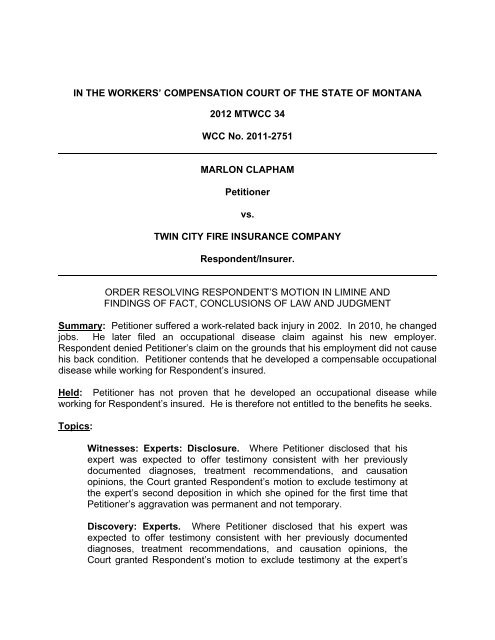
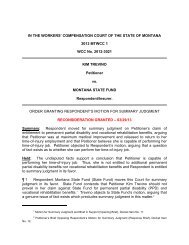
![Bustell v. AIG Claims Service, Inc. [05/03/05] 2005 MTWCC 23](https://img.yumpu.com/49777654/1/190x245/bustell-v-aig-claims-service-inc-05-03-05-2005-mtwcc-23.jpg?quality=85)
![Vallance v. MCCF [07/05/06] 2006 MTWCC 26 - Workers ...](https://img.yumpu.com/48724322/1/190x245/vallance-v-mccf-07-05-06-2006-mtwcc-26-workers-.jpg?quality=85)
